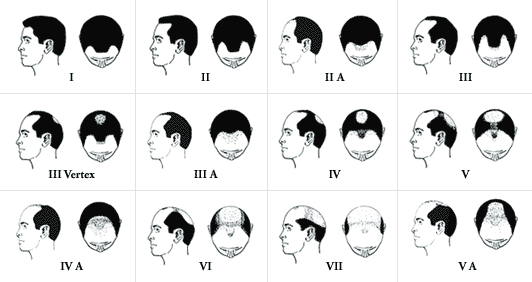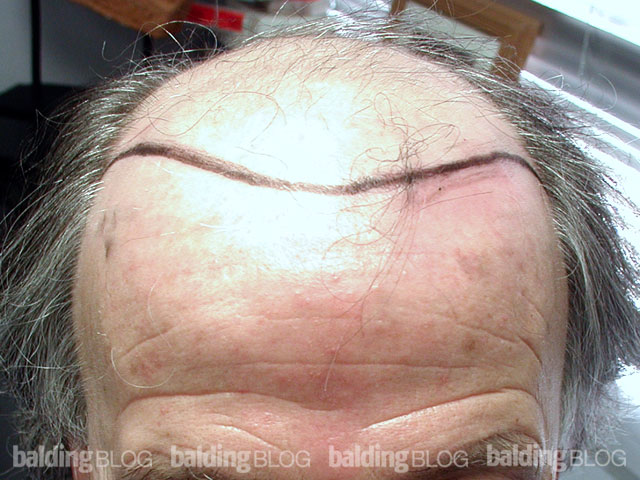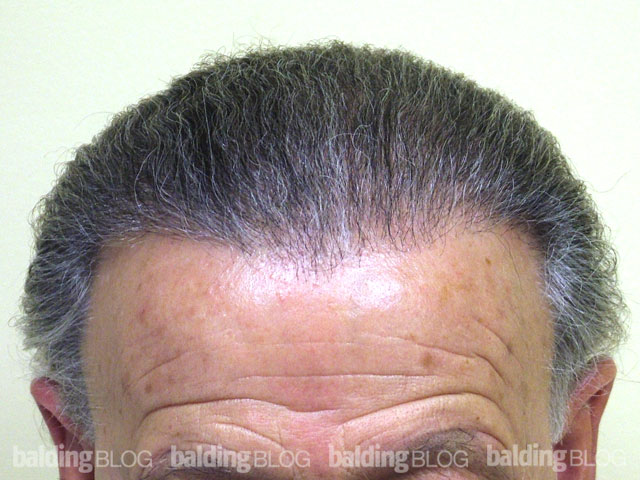Why is there such a difference between these two previous post’s photographs. They are both, by your report, Class 7 patients.
 Thanks for asking this great, insightful question.
Thanks for asking this great, insightful question.
The rim of hair in a Class 7 balding pattern contains about 30,000-35,000 hairs. Considering that the normal total hair count of an adult is about 100,000 hairs, the only permanent hair that is never lost in any balding man, is the 3 inch high rim of hair schematically shown on the right (Norwood Class 7 pattern). The art of hair transplantation that I will show you below, reflects the way the surgeon redistributes these 30,000 (or less) hairs so that it looks like more than it is. The surgeon needs all of the help he/she can get from the characteristics of the hair on the patient’s head, including the quantity that can be safely moved.
The texture of the hair in these two patients is very different. The white/grey haired man (let’s call him ZU) has a hair shaft thickness that is easily three times the hair bulk (weight) as the blonde fellow (and for the sake of consistency, we’ll call him BF). The hair of ZU has a good character to it and holds a wave nicely, while BF has hair that lies limp and wimpy. Also, the donor supply of ZU is easily twice as good as BF and has a loose scalp which allows the surgeon to redistribute more hair from the permanent rim of hair around the sides and back. ZU received almost 10,000 grafts with easily 23,000 hairs in these grafts, while BF had only 4500 grafts (about 8,000 hairs). BF’s scalp was tight and his hair density was not as good as ZU. With that understanding, re-read the blog post titled Patient’s Guide — How Many Grafts Will I Need?, and it should be easy to see that we are not all created equal and the surgeon’s hands are ‘tied’ by patient’s hair characteristics (weight, texture, color, quantity) and therefore the hair transplant surgeon is not in control of every variable he/she needs. When putting the patient’s final results side-by-side, ZU has easily 8-9 times the amount of hair bulk (# of hairs and bulk) as BF. What is very important for you, the reader, to recognize here is that even BF is thrilled with his results. The thinly covered crown in BF (both men use a comb-back hair styling technique) is not of a concern for BF, because he looks at the man in the mirror and does not see his hair from behind. ZU also has a comb-back (which I showed in these photos by allowing the hair that is combed back to separate so you can see the scalp) with much better coverage of his crown area. ZU also had a considerable amount of hair transplanted into the crown, making his grooming easier and his crown looking fuller. From BF’s point of view, that man he sees in the mirror has a full head of groomable hair, just like ZU.
It is also important to note that these men started getting hair transplants at different points of their hair loss. ZU was already completely bald when he started getting transplants, where BF was thinning rapidly and on his way to being completely bald (it happened a few years before Propecia became available). So ZU had nothing on his scalp when we began transplanting his head, and BF eventually lost all of his natural hair up top (so what you see in the photos for both men is all transplanted hairs). If you took BF’s hair transplants away, he would look like ZU’s before photo.
This is reality and that is why I appreciated this question when it came in yesterday. People with a Class 7 balding pattern will never have enough hair to replace what was lost (and if any doctor said he/she can give such a person a full head of hair, well, he/she clearly is must be GOD). The key to a good hair transplant is the artistic hand of the surgeon and good styling from the patient, no matter what balding pattern exists.
ZU (before on left, after in middle, after crown on right — more photos here):
BF (before on left, after in middle, after crown on right):



 Thanks for asking this great, insightful question.
Thanks for asking this great, insightful question.
